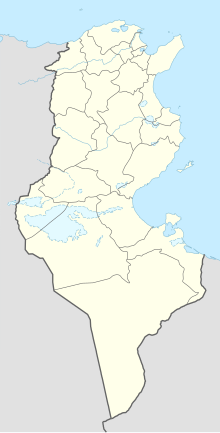Sidi Bou Said
Coordinates: 36 ° 52 ' N , 10 ° 20' E
Sidi Bou Saïd ( Arabic سيدي بوسعيد, DMG Sīdī Bū Saʿīd ) is an artist village about 20 km northeast of Tunis in the north of Tunisia . The village is located on the Rock of Carthage on the Gulf of Tunis .
history
The village was previously dedicated to religion . Here lived marabouts , religious recluse. The name is an abbreviation of the name of a saint named Abou Said ibn Khalef ibn Yahia Ettamini el Beji who lived here.
In 1207 the appointed mystic Abou Saïd Khalafa ben Yahia settled there to develop Sufism . After death he was canonized. The hill of Sidi Bou Saïd is revered as a sacred place.
In the 16th century, Moors settled here, as in the whole of northern Tunisia , and their architecture has shaped the village to this day.
The French-British Baron Rodolphe d'Erlanger settled in the then fishing village in 1912 and built a precious palace there. He made sure that the place was placed under monument protection in 1915. A painter and music lover, he opened his doors to artists by organizing get-togethers and evenings where art, music and literature mingled. The artists also included the German painters August Macke and Paul Klee during their trip to Tunis in 1914. After his death in 1932, von Erlanger bequeathed his cultural assets to Tunisia .
Touristic attractions
The tourist town is best known for its beautiful colors, its market ( souk ) and the Café des Nattes, made famous by a watercolor by August Macke. This is a typical Moorish café where, among other things, traditional shishas (water pipes) can be tried.
The newly christened palace of Erlanger, Ennejma Ezzahra , has become the center of Arabic and Mediterranean music. It is open to the public, who can admire the museum of musical instruments, the architecture and the gardens.
Sidi Bou Saïd has also become a meeting point for artists, from the young domestic bourgeoisie and foreign tourists. The place is known for its architecture with its old restored palaces.






